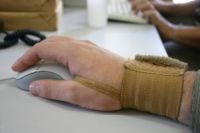 If you are a programmer, or work in front of a pc all day, and have been doing it for a while, I’m sure you’ve either experienced RSI yourself, or else you know someone who has. RSI, or Repetitive Strain Injury, is not something to be taken lightly as it can become quite serious if nothing is done to prevent it from worsening. Trust me, I should know since I came quite close to serious RSI.
If you are a programmer, or work in front of a pc all day, and have been doing it for a while, I’m sure you’ve either experienced RSI yourself, or else you know someone who has. RSI, or Repetitive Strain Injury, is not something to be taken lightly as it can become quite serious if nothing is done to prevent it from worsening. Trust me, I should know since I came quite close to serious RSI.
RSI symptoms are not always the same for everyone. Most people feel symptoms in their hands, but it can also affect the arms, shoulders, the neck, the chest and the back. RSI is more of a whole body problem then just a hand issue – at least that’s what it felt like for me.
My Experience
I’m a full-time programmer, and have been in the industry for over 7 years now. That might not seem like a whole lot but look at it this way – I work 8 hours a day, 5 days a week for approximately 52 weeks a year. If you do the math that adds up to 2,080 hours of programming a year. Now obviously you have to deduct paid leave and sick leave from that equation, but you also have to add weekends because I do spend a lot of them in front of the pc as well. Now, multiply that by 7 years and we have 14,560 hours spent in front of the pc typing and clicking. That’s quite a lot of typing and clicking. Now imagine doing that for your whole career – 30 or 40 years. I can assure you that you will experience some form of RSI if you do not take the necessary precautions. I did, after 6 years, and although it has gotten a lot better I am still experiencing certain problems.
 It all started with a tingling sensation in my index and middle fingers on both hands. Although the strange thing was that this tingling occurred while I was driving and at night while sleeping. At first it never occurred when I was in front of the pc, which led me to believe it was not RSI.
It all started with a tingling sensation in my index and middle fingers on both hands. Although the strange thing was that this tingling occurred while I was driving and at night while sleeping. At first it never occurred when I was in front of the pc, which led me to believe it was not RSI.
So, just as most people do, I ignored it.
But then it started getting worse. After a few days it wasn’t just a tingling sensation any more. It had turned into light numbness of the thumb, index finger and middle finger. And it was starting to irritate me because I couldn’t do normal day to day stuff with my hands, such as reading a book or holding a fork and knife while having dinner. My hands would go numb for no reason.
So I went to see a doctor.
He examined my hands and concluded that it could be either Carpal Tunnel Syndrome, or a pinched nerve in my neck area. He suggested I adjust my seating position at work and also referred me to a specialist.
The next day I went to work and fiddled around with my chair until I set it up in what I thought was a more ergonomic position. I worked for a few days in that position but then started feeling pain in other places, more specifically my neck and chest. Apart from this my hands were still getting worse. I could no longer carry heavy items, not even a grocery bag. I would wake up at night with shooting pain in my arms and unable to move them due to numbness. At this point of my life RSI was a real problem.
 I have a friend at work who also experienced RSI problems, so I went and asked his opinion. He had also been referred to the same specialist that my doctor referred me to, but he had also been operated on by this specialist. The specialist had concluded that my friend had Carpal Tunnel Syndrome so he operated on his wrist and tried to fix the problem. The bad news was that according to my friend, he was still feeling the pain, so the operation did not really solve the issue. This worried me since no one wants to be operated on for nothing.
I have a friend at work who also experienced RSI problems, so I went and asked his opinion. He had also been referred to the same specialist that my doctor referred me to, but he had also been operated on by this specialist. The specialist had concluded that my friend had Carpal Tunnel Syndrome so he operated on his wrist and tried to fix the problem. The bad news was that according to my friend, he was still feeling the pain, so the operation did not really solve the issue. This worried me since no one wants to be operated on for nothing.
So I decided to learn all I could regarding RSI – why it happens, what the symptoms are, and most importantly how to prevent it. I went to Amazon.com and searched for books on the subject. I was quite surprised to see how many books there actually is on this subject. Then I started the process of filtering through the books to find one with a good review and that applies to my case.
And I found “It’s Not Carpal Tunnel Syndrome!” by Suparna Damany and Jack Bellis.
The title of this book reminded me of my friend’s case, so I decided to buy it. In about a week or so it had arrived and by this time I was dying to read it. After about 5 minutes of reading my hands went numb again so I went down to the local pharmacy and bought a pair of hand braces. Hand braces are these straps you wrap around your wrist and part of your arm, and they keep your wrist from bending downwards, therefore keeping your hands from going numb. Anyway, I bought these straps, put them on and started reading the book. And to my surprise it turned out to be a pretty good book.
What “It’s Not Carpal Tunnel Syndrome!” taught me.
The book is aimed at computer professionals. In fact, one of the authors is a programmer while the other is a Certified Hand Therapist and a Certified Ergonomic Assessment Specialist.
 The primary lesson I got from this book is that it usually is not carpal tunnel syndrome. The book clearly explains how RSI is not just a hand problem, but the pain felt in the hands is usually coming from other parts of your body. It explains the theories behind RSI, and helps you understand which muscles and nerves are being affected. It helps you diagnose the problem and explains what therapies are available to help you recover from RSI. The book also helps you to properly set up an ergonomic seating position at your pc, and gives you ideas to help reduce your muscle tension.
The primary lesson I got from this book is that it usually is not carpal tunnel syndrome. The book clearly explains how RSI is not just a hand problem, but the pain felt in the hands is usually coming from other parts of your body. It explains the theories behind RSI, and helps you understand which muscles and nerves are being affected. It helps you diagnose the problem and explains what therapies are available to help you recover from RSI. The book also helps you to properly set up an ergonomic seating position at your pc, and gives you ideas to help reduce your muscle tension.
Apart from helping you understand why RSI happens, the book also describes exercises you can perform yourself to help reduce the pain and numbness. I followed these exercises and stretching routines and found that they really do help.
I was so happy that finally something was working and my pain was slowly going away. I now clearly understood what nerves were causing the numbness and how to perform nerve glide exercises and stretching exercises which would help me loosen up and reduce the strain on the effected nerves.
I have been following these exercises for over 6 months now and I can honestly say that they work and my RSI symptoms have been fading away. I also requested my employer provide me with a keyboard and mouse wrist support and I feel that these supports have helped as well.
Since the exercising and stretching really helped I cancelled my appointment with the specialist because I didn’t see it necessary any more. For me the book was enough to get my hands almost back to normal. Occasionally I still feel some very light numbness but it is continuously getting better, so I really feel I should recommend this book.
You can have a look at the book on Amazon.com.
Obviously, I am not a medical expert, so if you feel that stretching and exercising is not helping you do seek a medical opinion as soon as possible.
I hope this article has helped you in some way. What do you have to say about RSI? Have you experienced it? Is RSI still a continious struggle for you? Let us know what your thoughts on RSI are in the comments below.
Also, if you want to ask me a question on RSI feel free to conatct me through my contact page.
David Azzopardi
RSI victim recovering
